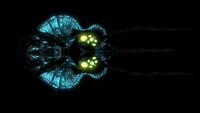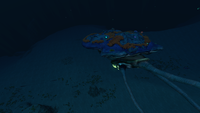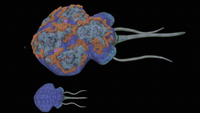Reefback Leviathan: Difference between revisions
Edgelord2001 (talk | contribs) No edit summary |
m (Reefback -> Reefback Leviathan) |
||
| Line 1: | Line 1: | ||
{{Class_2_Fauna|title1 = Reefback Leviathan |
{{Class_2_Fauna|title1 = Reefback Leviathan Leviathan |
||
|image1 = |
|image1 = |
||
<gallery> |
<gallery> |
||
Reefback Fauna.png|Adult |
Reefback Leviathan Fauna.png|Adult |
||
Reefback Leviathan_Fauna_Juvenile.png|Juvenile |
|||
</gallery> |
</gallery> |
||
|category = Herbivores |
|category = Herbivores |
||
| Line 21: | Line 21: | ||
'''Adult:''' <i>reefback</i> |
'''Adult:''' <i>reefback</i> |
||
'''Juvenile''':<i>2560</i> |
'''Juvenile''':<i>2560</i> |
||
|image2 = Reefback Egg.png |
|image2 = Reefback Leviathan Egg.png |
||
|tab2 = [[Eggs]] |
|tab2 = [[Eggs]] |
||
|description2 = Incredibly, |
|description2 = Incredibly, Reefback Leviathans hatch from these. |
||
|biome2 = * - |
|biome2 = * - |
||
|size = |
|size = |
||
* [[File:Reefback Egg.png|30px]] 9 (3x3) |
* [[File:Reefback Leviathan Egg.png|30px]] 9 (3x3) |
||
* [[File:Reefback.png|30px]] 16 (4x4) |
* [[File:Reefback Leviathan.png|30px]] 16 (4x4) |
||
|bioreactor = * [[File:Reefback Egg.png|30px]] +280 Energy |
|bioreactor = * [[File:Reefback Leviathan Egg.png|30px]] +280 Energy |
||
* [[File:Reefback.png|30px]] +840 Energy |
* [[File:Reefback Leviathan.png|30px]] +840 Energy |
||
|dna = |
|dna = |
||
|item_id = <i>reefbackegg</i> |
|item_id = <i>reefbackegg</i> |
||
|incubation = * [[File:Alien Containment.png|30px|link=Alien Containment]] 3 (day/s) |
|incubation = * [[File:Alien Containment.png|30px|link=Alien Containment]] 3 (day/s) |
||
}}The '''Reefback''' '''Leviathan''' is a passive [[Leviathan Class Organisms|leviathan class]] [[fauna]] species. It is the second largest passive life form, and ties with the [[Sea Dragon Leviathan]] for second largest creature overall. |
}}The '''Reefback Leviathan''' '''Leviathan''' is a passive [[Leviathan Class Organisms|leviathan class]] [[fauna]] species. It is the second largest passive life form, and ties with the [[Sea Dragon Leviathan]] for second largest creature overall. |
||
==Appearance== |
==Appearance== |
||
The Reefback is massive in size, with most of the creature's body being comprised of a thick, dark-blue carapace with a rounded, triangular front, and a relatively small body concentrated in the posterior. Attached to its main body are three long whip-like tentacles. |
The Reefback Leviathan is massive in size, with most of the creature's body being comprised of a thick, dark-blue carapace with a rounded, triangular front, and a relatively small body concentrated in the posterior. Attached to its main body are three long whip-like tentacles. |
||
An adult Reefback has patches of teal-colored coral and brown-colored grass growing across its carapace, befitting its name, while the younger ones lack this trait. The carapace has a slightly bright blue dotted pattern across towards the back. beneath its carapace, it is dark green with light blue [[Bioluminescence|bioluminescent]] stripes on the sides and in the middle. On either side of its body are eight yellow bioluminescent bulbs. The purpose of these is unknown, though the data bank entry notes a visual similarity to the [[Gasopod]] algae gland. They could also be very underdeveloped eyes, which might suggest the Reefback has some other means of "seeing" its surroundings. Two siphon-esque structures that constantly expand and retract as the creature moves are located next to these bulbs. |
An adult Reefback Leviathan has patches of teal-colored coral and brown-colored grass growing across its carapace, befitting its name, while the younger ones lack this trait. The carapace has a slightly bright blue dotted pattern across towards the back. beneath its carapace, it is dark green with light blue [[Bioluminescence|bioluminescent]] stripes on the sides and in the middle. On either side of its body are eight yellow bioluminescent bulbs. The purpose of these is unknown, though the data bank entry notes a visual similarity to the [[Gasopod]] algae gland. They could also be very underdeveloped eyes, which might suggest the Reefback Leviathan has some other means of "seeing" its surroundings. Two siphon-esque structures that constantly expand and retract as the creature moves are located next to these bulbs. |
||
==Behavior== |
==Behavior== |
||
The Reefback drifts slowly and gently around the open waters of many [[biomes]], mostly seen swimming in pods of more than two. It almost never adjusts its current altitude, unless bumped against obstacles. |
The Reefback Leviathan drifts slowly and gently around the open waters of many [[biomes]], mostly seen swimming in pods of more than two. It almost never adjusts its current altitude, unless bumped against obstacles. |
||
Juvenile |
Juvenile Reefback Leviathans are a quarter the size of an adult. They can often be found with adults in certain locations. |
||
The Reefback will frequently emit a range of echoing, low-frequency calls. They will only emit these calls if there are other' |
The Reefback Leviathan will frequently emit a range of echoing, low-frequency calls. They will only emit these calls if there are other'Reefback Leviathans nearby. This suggests that these calls are a form of communication, as opposed to echolocation. |
||
When |
When Reefback Leviathans are exposed to damage, their tentacles will wave quickly and they will move slightly faster for a brief period. |
||
==Mini-ecosystem== |
==Mini-ecosystem== |
||
Adult |
Adult Reefback Leviathans can support mini-ecosystems on their back. These ecosystems include many types of [[flora]] and [[coral]], along with other small fauna swimming in the vicinity of the gentle giants. Some caution should be taken when approaching Reefback Leviathans, as [[Tiger Plant]]s often make their homes on their backs. Adult Reefback Leviathans often have barnacles growing on their back. These barnacles are Harvesting Nodes, and can be broken to will reveal resources, similair to limestone, shale, or sandstone outcrops. Currently, they only drop two resources: [[Silver Ore]] and [[Copper Ore]]. Copper ore is the most frequent resource to find. |
||
<tabber> |
<tabber> |
||
| Line 90: | Line 90: | ||
==Energy Value== |
==Energy Value== |
||
{{Recipe2}} |
{{Recipe2}} |
||
{{Recipe2|page = Reefback Egg}} |
{{Recipe2|page = Reefback Leviathan Egg}} |
||
==Data Bank Entry== |
==Data Bank Entry== |
||
{| class="article-table sortable" style="width: 100%;" border="0" cellpadding="1" cellspacing="1" |
{| class="article-table sortable" style="width: 100%;" border="0" cellpadding="1" cellspacing="1" |
||
|- |
|- |
||
! class="unsortable" style="width: 100%; text-align: center;" |[[File:Reefback-1.png|centre|660px]] |
! class="unsortable" style="width: 100%; text-align: center;" |[[File:Reefback Leviathan-1.png|centre|660px]] |
||
|- |
|- |
||
| style="text-align:left; font-size:12px;" | |
| style="text-align:left; font-size:12px;" | |
||
| Line 103: | Line 103: | ||
# Enzyme Pods:<br />Similar in appearance to the algae glands of the gasopod, these organs on the reefback's underside serve some unknown purpose in its digestive system, and are capable of expelling small quantities of stomach enzymes into the surrounding waters.<br /> |
# Enzyme Pods:<br />Similar in appearance to the algae glands of the gasopod, these organs on the reefback's underside serve some unknown purpose in its digestive system, and are capable of expelling small quantities of stomach enzymes into the surrounding waters.<br /> |
||
# Local Microcosm:<br />An array of different barnacle and plant species grow on the reefback's shell, thrusting their roots into ancient scars in the chitin, and taking advantage of their mobility to avoid predation. Nonetheless reefbacks will often be pursued by the faster, hungrier herbivores, and thus this leviathan species is a mobile microcosm worthy of years of study in itself.<br /> |
# Local Microcosm:<br />An array of different barnacle and plant species grow on the reefback's shell, thrusting their roots into ancient scars in the chitin, and taking advantage of their mobility to avoid predation. Nonetheless reefbacks will often be pursued by the faster, hungrier herbivores, and thus this leviathan species is a mobile microcosm worthy of years of study in itself.<br /> |
||
# Lifecycle:<br /> |
# Lifecycle:<br />Reefback Leviathans's lifespans likely extend through many centuries, should they survive their initial growth cycle. For the first few decades their smaller size would make them vulnerable to carnivorous leviathans. Sociable, seen traveling in small pods and communicating by an echoing call, behavior is consistent with low-level sentience. |
||
| Line 118: | Line 118: | ||
Screenshots= |
Screenshots= |
||
<gallery widths="200" spacing="small"> |
<gallery widths="200" spacing="small"> |
||
Reefback LeviathanA.jpg|Side Profile |
|||
Reefback LeviathanC.jpg|Front view |
|||
Reefback LeviathanB.jpg|Dorsal view |
|||
Reefback Leviathan12.jpg|Lower extremities |
|||
Newreefback4.jpg|Bioluminescence |
Newreefback4.jpg|Bioluminescence |
||
Reefback Leviathan11.jpg|Size comparison between an adult Reefback Leviathan and the [[Player]] |
|||
reeeeeeeeeeef.jpg|Size comparison with a [[Reaper Leviathan]] |
reeeeeeeeeeef.jpg|Size comparison with a [[Reaper Leviathan]] |
||
Reefback LeviathanJuvenileSizeref.jpg|A size comparison between a juvenile Reefback Leviathan and the player |
|||
RbBKZ.png|A Reefback above the [[Blood Kelp Zone]] |
RbBKZ.png|A Reefback Leviathan above the [[Blood Kelp Zone]] |
||
RbDunes.png|A single Reefback in the [[Dunes]] |
RbDunes.png|A single Reefback Leviathan in the [[Dunes]] |
||
RbGP.png|An adult and juvenile Reefback in the [[Grassy Plateaus]] |
RbGP.png|An adult and juvenile Reefback Leviathan in the [[Grassy Plateaus]] |
||
RbKoosh.png|Two adult |
RbKoosh.png|Two adult Reefback Leviathans in the [[Bulb Zone]] |
||
2017-05-23_00002.jpg|A Reefback, close enough to the surface for the player to "ride" |
2017-05-23_00002.jpg|A Reefback Leviathan, close enough to the surface for the player to "ride" |
||
</gallery> |
</gallery> |
||
|-| |
|-| |
||
Concept Art= |
Concept Art= |
||
<gallery widths="200" spacing="small"> |
<gallery widths="200" spacing="small"> |
||
Reefback Concept Art.jpg|[[Concept Art]] |
Reefback Leviathan Concept Art.jpg|[[Concept Art]] |
||
</gallery> |
</gallery> |
||
</tabber> |
</tabber> |
||
== Trivia == |
== Trivia == |
||
* [[Shoal of Fish|Schools]] of [[Bladderfish]] can only be found near |
* [[Shoal of Fish|Schools]] of [[Bladderfish]] can only be found near Reefback Leviathans. |
||
* |
* Reefback Leviathans are capable of transporting the [[player]] when near the surface. |
||
* Juveniles can be found infected with Kharaa, whereas the adults can not. |
* Juveniles can be found infected with Kharaa, whereas the adults can not. |
||
* |
* Reefback Leviathans were initially intended to submerge themselves in sandy areas. Increased activity about them would have made them rise in search for a peaceful place to rest.<ref>https://docs.google.com/document/d/1kd4YTHJz2K4ERdGRfJB-8M7_32Q23clIBRqEMrLmysk/edit#</ref> It is unknown if this will be implemented. |
||
* Another intended interaction would've been that the player could grab a hold of a Reefback's tentacles to hitch a ride or hide on their plant-covered backs to hide from predators.<ref>https://docs.google.com/document/d/1kd4YTHJz2K4ERdGRfJB-8M7_32Q23clIBRqEMrLmysk/edit</ref> It is unknown if this will be implemented. |
* Another intended interaction would've been that the player could grab a hold of a Reefback Leviathan's tentacles to hitch a ride or hide on their plant-covered backs to hide from predators.<ref>https://docs.google.com/document/d/1kd4YTHJz2K4ERdGRfJB-8M7_32Q23clIBRqEMrLmysk/edit</ref> It is unknown if this will be implemented. |
||
* |
* Reefback Leviathans used to be much smaller than they currently are, and had the same texture that is currently given to juvenile Reefback Leviathans. |
||
==References== |
==References== |
||
Revision as of 16:24, 3 May 2018
Template:Class 2 FaunaThe Reefback Leviathan Leviathan is a passive leviathan class fauna species. It is the second largest passive life form, and ties with the Sea Dragon Leviathan for second largest creature overall.
Appearance
The Reefback Leviathan is massive in size, with most of the creature's body being comprised of a thick, dark-blue carapace with a rounded, triangular front, and a relatively small body concentrated in the posterior. Attached to its main body are three long whip-like tentacles.
An adult Reefback Leviathan has patches of teal-colored coral and brown-colored grass growing across its carapace, befitting its name, while the younger ones lack this trait. The carapace has a slightly bright blue dotted pattern across towards the back. beneath its carapace, it is dark green with light blue bioluminescent stripes on the sides and in the middle. On either side of its body are eight yellow bioluminescent bulbs. The purpose of these is unknown, though the data bank entry notes a visual similarity to the Gasopod algae gland. They could also be very underdeveloped eyes, which might suggest the Reefback Leviathan has some other means of "seeing" its surroundings. Two siphon-esque structures that constantly expand and retract as the creature moves are located next to these bulbs.
Behavior
The Reefback Leviathan drifts slowly and gently around the open waters of many biomes, mostly seen swimming in pods of more than two. It almost never adjusts its current altitude, unless bumped against obstacles.
Juvenile Reefback Leviathans are a quarter the size of an adult. They can often be found with adults in certain locations.
The Reefback Leviathan will frequently emit a range of echoing, low-frequency calls. They will only emit these calls if there are other'Reefback Leviathans nearby. This suggests that these calls are a form of communication, as opposed to echolocation.
When Reefback Leviathans are exposed to damage, their tentacles will wave quickly and they will move slightly faster for a brief period.
Mini-ecosystem
Adult Reefback Leviathans can support mini-ecosystems on their back. These ecosystems include many types of flora and coral, along with other small fauna swimming in the vicinity of the gentle giants. Some caution should be taken when approaching Reefback Leviathans, as Tiger Plants often make their homes on their backs. Adult Reefback Leviathans often have barnacles growing on their back. These barnacles are Harvesting Nodes, and can be broken to will reveal resources, similair to limestone, shale, or sandstone outcrops. Currently, they only drop two resources: Silver Ore and Copper Ore. Copper ore is the most frequent resource to find.
<tabber> Fauna=
- Biter
- Bladderfish
- Boomerang
- Eyeye
- Holefish
- Hoopfish
- Hoverfish
- Peeper
- Reginald
- Shoal of Fish
- Spadefish
|-| Flora=
- Acid Mushroom
- Blood Grass
- Furled Papyrus
- Regress Shell
- Rouge Cradle
- Spotted Reeds
- Tiger Plant
- Veined Nettle
- Violet Beau
- Writhing Weed
|-| Coral=
|-| Harvesting Node=
</tabber>
Energy Value
(no target detected) (no target detected)
Data Bank Entry
|
This vast lifeform is in excess of 30m long and has been designated leviathan class. Fortunately it feeds exclusively on plankton-like lifeforms in the water.
Assessment: Harbors plants, small fish and metal-rich barnacles |
Gallery
<tabber> Screenshots=
- Reefback LeviathanA.jpg
Side Profile
- Reefback LeviathanC.jpg
Front view
- Reefback LeviathanB.jpg
Dorsal view
- Reefback Leviathan12.jpg
Lower extremities
- Reefback Leviathan11.jpg
Size comparison between an adult Reefback Leviathan and the Player
Size comparison with a Reaper Leviathan
- Reefback LeviathanJuvenileSizeref.jpg
A size comparison between a juvenile Reefback Leviathan and the player
A Reefback Leviathan above the Blood Kelp Zone
A single Reefback Leviathan in the Dunes
An adult and juvenile Reefback Leviathan in the Grassy Plateaus
Two adult Reefback Leviathans in the Bulb Zone
|-| Concept Art=
- Reefback Leviathan Concept Art.jpg
</tabber>
Trivia
- Schools of Bladderfish can only be found near Reefback Leviathans.
- Reefback Leviathans are capable of transporting the player when near the surface.
- Juveniles can be found infected with Kharaa, whereas the adults can not.
- Reefback Leviathans were initially intended to submerge themselves in sandy areas. Increased activity about them would have made them rise in search for a peaceful place to rest.[1] It is unknown if this will be implemented.
- Another intended interaction would've been that the player could grab a hold of a Reefback Leviathan's tentacles to hitch a ride or hide on their plant-covered backs to hide from predators.[2] It is unknown if this will be implemented.
- Reefback Leviathans used to be much smaller than they currently are, and had the same texture that is currently given to juvenile Reefback Leviathans.
References
Lua error in package.lua at line 80: module 'Dev:Navbox' not found.







